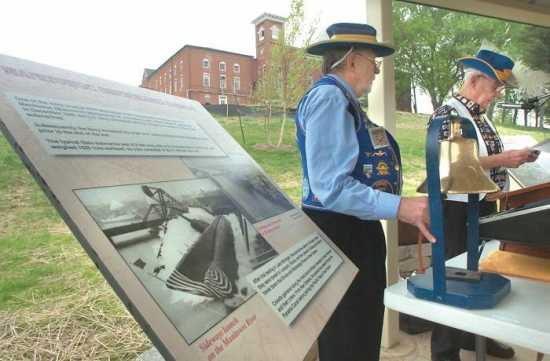WWII submarine route commemorated on riverfront
________________________________________________________________
Semissourian
By Chris Pagano
April 16, 2006

Paul W. Wittmer, left, and Jack Tolliver conducted a tolling
ceremony for the 52 U.S. submarines lost during World War
II, at the close of the dedication Saturday of a storyboard
display erected at the River Campus of Southeast Missouri
State University. A photograph shows the sideways launch
of a Manitowoc, Wis.-built submarine on the Manitowoc River.
(Fred Lynch)
Located at the base of the Bill Emerson Memorial Bridge, the storyboard depicts the tale of U.S. submarines built in Manitowoc, Wis., which were transported down the Mississippi River, commissioned in New Orleans and sent to the Pacific Theater during the war.
Twenty-eight Manitowoc-built submarines passed Cape Girardeau from 1942 to 1945. Four of those were later lost at sea with their crews.
Vance Combs of Cape Girardeau, who served on the USS Cobia as a radio operator from 1943 to 1946, attended with local family members and a granddaughter from Kentucky.
Combs said his reasons for volunteering to be a submariner were simple: ego and hazardous duty pay. Because only the top 5 percent were picked from U.S. Navy Radio School, it was an honor to be a part of this elite group responsible for "special missions," including conducting reconnaissance, landing guerrillas, laying minefields, searching for enemy minefields and rescuing aviators.
"After the war I found out we were six times more likely to die," he said. "But we were young, and although there was lots of boredom traveling across shipping lanes, trouble was all part of it."
He said only a fourth of the volunteers got into sub school to begin with because of the intense psychological and physical testing to determine the tolerance for pressure.
Tom Crites, now of Indiana, formerly of Sedgewickville, served on the USS Pargo 264, which saw a lot of battle. His vest tells the story. One large patch depicted 14 merchant ships sunk, nine damaged, an island bombarded and a military ship damaged by his ship.
U.S. Submarine Veterans of World War II state commander Paul W. Wittner and past national president Jack Tolliver recognized Lisa Howe, project manager and engineer, as one of the two most instrumental in seeing the storyboard become a reality. The other was Art Randall, vice president of the Ill.-Mo. Squadron and central region director of U.S. Sub Vets Inc.
____
www.schnorkel.blogspot.com
Semissourian
By Chris Pagano
April 16, 2006

Paul W. Wittmer, left, and Jack Tolliver conducted a tolling
ceremony for the 52 U.S. submarines lost during World War
II, at the close of the dedication Saturday of a storyboard
display erected at the River Campus of Southeast Missouri
State University. A photograph shows the sideways launch
of a Manitowoc, Wis.-built submarine on the Manitowoc River.
(Fred Lynch)
The river turned another tale Saturday when about 30 people, including members of U.S. Submarine Veterans of World War II, gathered at the Southeast Missouri State University River Campus gazebo to dedicate a commemorative storyboard and toll the bell for 52 U.S. submarines lost during the war.
Located at the base of the Bill Emerson Memorial Bridge, the storyboard depicts the tale of U.S. submarines built in Manitowoc, Wis., which were transported down the Mississippi River, commissioned in New Orleans and sent to the Pacific Theater during the war.
Twenty-eight Manitowoc-built submarines passed Cape Girardeau from 1942 to 1945. Four of those were later lost at sea with their crews.
Vance Combs of Cape Girardeau, who served on the USS Cobia as a radio operator from 1943 to 1946, attended with local family members and a granddaughter from Kentucky.
Combs said his reasons for volunteering to be a submariner were simple: ego and hazardous duty pay. Because only the top 5 percent were picked from U.S. Navy Radio School, it was an honor to be a part of this elite group responsible for "special missions," including conducting reconnaissance, landing guerrillas, laying minefields, searching for enemy minefields and rescuing aviators.
"After the war I found out we were six times more likely to die," he said. "But we were young, and although there was lots of boredom traveling across shipping lanes, trouble was all part of it."
He said only a fourth of the volunteers got into sub school to begin with because of the intense psychological and physical testing to determine the tolerance for pressure.
Tom Crites, now of Indiana, formerly of Sedgewickville, served on the USS Pargo 264, which saw a lot of battle. His vest tells the story. One large patch depicted 14 merchant ships sunk, nine damaged, an island bombarded and a military ship damaged by his ship.
U.S. Submarine Veterans of World War II state commander Paul W. Wittner and past national president Jack Tolliver recognized Lisa Howe, project manager and engineer, as one of the two most instrumental in seeing the storyboard become a reality. The other was Art Randall, vice president of the Ill.-Mo. Squadron and central region director of U.S. Sub Vets Inc.
____
www.schnorkel.blogspot.com

0 Comments:
Post a Comment
<< Home